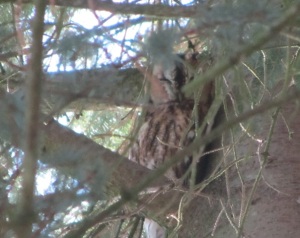Continuing the observations on my 2011/12 wildlife survey of a Highland Perthshire estate. This tale is in three parts – Part 1:
Monday 5 March 2012. Weather: Cold wind first thing but the day warmed up in the sunshine and the wind became weaker by 1000 am. Clouded slightly at midday, then quickly returned to full sun. Peaked at 11 degrees.
My attention was immediately taken by two new inhabitants of the estate loch on my arrival for my day’s wildlife survey. With the brief glance I had I was sure that new arrivals were Canada geese, and I went on to the veranda of the shooting lodge overlooking the loch to confirm. Sure enough a Canada goose and gander were proudly resting on the island, the gander considerably larger and slightly paler in colour. The four resident mute swans were close by and there seemed to be no animosity with their recently-arrived wildfowl cousins. As I watched them I became aware of a blackbird chattering in the small conifer wood adjacent to the lodge. I couldn’t see the blackbird, but knew its tone meant an avian predator, probably an owl. Blackbirds in particular are great at letting any observer know what is about – provided of course the observer can read the signs. In contrast to the high pitched chattering, the blackbird gives a single note pink if it spots a predator such as a cat, stoat or weasel on the ground, with this warning repeated for as long as the danger persists. I could now see two chaffinches joining in the warning, emitting a similar pinking note, though pitched higher than that of the blackbird. They were nervously flitting about the branches half-way up a sitka spruce tree near the corner of the wood.
I went round the lodge to get to the edge of the wood and looked up into the trees. Barely visible, and blending perfectly with the trunk and branches, was a tawny owl. It was tight against the trunk of the tree, and had I not been peering up with some confidence of what would be there I probably wouldn’t have seen it. With my presence the small birds had gone, their whistle-blowing job done. Having brown feathers streaked down the breast with white, the owl merged perfectly with the dappled shade of the woodland. Its head looked almost as wide as its body, with a creamy white semi-circle on each side and a brown stripe down the centre, ending in its beak. Its eyes were firmly shut, and it seemed to be enjoying its siesta despite its raucous and inconsiderate neighbours. This could well have been the owl that I heard on my visit a mere five days before. I went to the car for my camera and managed to get a few decent photos that rather surprisingly looked as if I were opposite the bird rather than underneath it.
I came back to the veranda and sat for a few minutes, having during my earlier Canada goose observations heard a bird that always brings back many childhood memories, but had been briefly forgotten because of the owl. I looked across to the marshy part of Brodie’s Moor between the gamekeeper’s house and the junipers, where there was a lapwing displaying; rising in the air, then diving back towards the ground again twisting and turning as it did so, all the while rendering its lovely peeee-weep, weep-weep, peeee-weep call, evocative of the months of March and April, and which of course gives the bird its countryside name of peeweep or peewit. When these birds were much more common on arable land, we, as boys, always stopped the small grey Fergie tractor to move and replace the nest, or harrowed or rolled round it rather than flatten the four olive spotted eggs with the pointed ends all facing the centre of the rudimentary straw and stone nest so that the bird could more easily incubate them. With the more modern much larger tractors, now all with cabs, it would be doubtful if their driver would be able to see any nest. This factor, coupled with an increase in insecticides that wipe out the essential food supply for so many young birds, the late rolling of fields with grain long-since sown and already through the ground (briered, in farming terms)plus the very late cultivation for a pea crop of fields ploughed much earlier in the year all result in eggs and chicks being flattened and have combined to all but banish lapwings from arable land. They are now virtually consigned to moorland edges and marshland such as Brodie’s Moor. Even on moorland, with less predator control nowadays, a high proportion of chicks and eggs are still hoovered up by crows, gulls and foxes.


